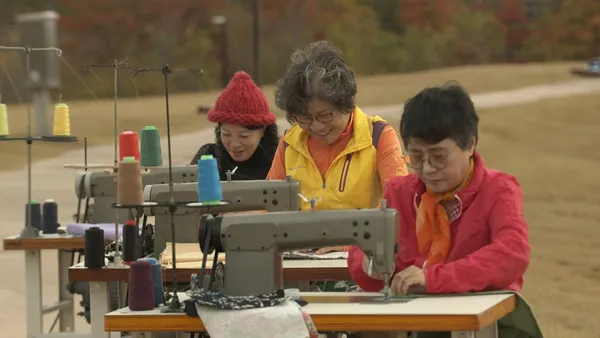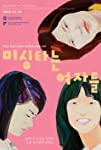Eye For Film >> Movies >> Sewing Sisters (2020) Film Review
Sewing Sisters
Reviewed by: Jennie Kermode

A simple line drawing shows a woman kneeling, bent over. It could be an image of devotion from almost any point in Korean history, yet there is nothing holy about this. It doesn’t represent a position taken briefly as a mark of obeisance; rather, it depicts the position in which a 13-year-old girl was expected to work at a sewing machine for 12 hour shifts and more, never straightening her back for fear of incurring her supervisor’s wrath, never leaning too far forward for fear of getting her hair caught in the machine. She was one of many such girls are young women who worked in the factories of Seoul’s Pyeonghwa Market district. When we see them today, preparing to visit an art exhibition which explores their lives and legacy, many of their bodies still show signs of the long term damage that was done to them.
What is it that makes these ordinary working class women so significant? It’s the fact that they fought back. The exhibition, and this documentary by Kim Jung-young and Lee Hyuk-rae, charts their struggle to win concessions on basic health and safety in the workplace and the right to sensible shift patterns, days off and decent compensation – the very basics of what an employee today might expect. This wasn’t all about marches and stand-offs and noisy protests. It began with something much simpler, as those interviewed in the film explain: the growing recognition, in response to new philosophy whispered through their ranks, that they were worth something and deserved to be treated decently.
Employers don’t like the idea that their workers are radicalising one another behind their backs. In a country like South Korea, only recently divided from its northern neighbour at that time, it also suggested something like sedition. Ironically, whilst the Western-style democracies of the era demonised Communist countries by citing terrible working conditions in their factories, what these women went through doesn’t sound very different, and the way those in power responded to their protests was not so different from what they might have expected from a totalitarian regime. Suspected of sharing Communist sympathies because of their union organising, they faced a siege, police violence and terrible prison conditions – when some of them were still only young teenagers. Their memories of this remain vivid. Kim and Lee layer different accounts to build up a picture of key events as seen from multiple angles.
Was it worse because they were women? A couple of men contribute too, but their accounts are notably different. Often the girls were sent to work to support desperate families, in lieu of going to school; part of the appeal of the union movement was that it offered an education. There was an inherent social distrust of women who chose to work so that they could live independently, and any woman who got married was expected to leave the workplace, which might then mean ending her education too, leaving her completely dependent. one woman talks about being forced to choose between a career and her fiance, and how that impacted her.
Between 1960 and 1980, South Korea’s economy grew at an astonishing rate, with its textiles sector booming. This documentary, which screened as part of the 2021 London Korean Film Festival, explains something of how that happened, and what it cost.
Reviewed on: 20 Nov 2021

















